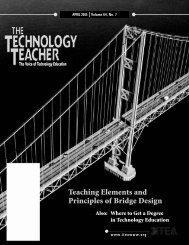K-12 Engineering Education Standards: - International Technology ...
K-12 Engineering Education Standards: - International Technology ...
K-12 Engineering Education Standards: - International Technology ...
You also want an ePaper? Increase the reach of your titles
YUMPU automatically turns print PDFs into web optimized ePapers that Google loves.
Research indicates that individuals learn and apply broad 21st century skills within the context of specific bodies of<br />
knowledge (National Research Council, 2008a, 2000; Levy and Murnane, 2004). At work, development of these skills is<br />
intertwined with development of technical job content knowledge. Similarly, in science education, students may develop<br />
cognitive skills while engaged in study of specific science topics and concepts.<br />
1. Adaptability: The ability and willingness to cope with uncertain, new, and rapidly changing conditions on the job,<br />
including responding effectively to emergencies or crisis situations and learning new tasks, technologies, and<br />
procedures. Adaptability also includes handling work stress; adapting to different personalities, communication styles,<br />
and cultures; and physical adaptability to various indoor or outdoor work environments (Houston, 2007; Pulakos, Arad,<br />
Donovan, and Plamondon, 2000).<br />
2. Complex communications/social skills: Skills in processing and interpreting both verbal and nonverbal information from<br />
others in order to respond appropriately. A skilled communicator is able to select key pieces of a complex idea to express<br />
in words, sounds, and images in order to build shared understanding (Levy and Murnane, 2004). Skilled communicators<br />
negotiate positive outcomes with customers, subordinates, and superiors through social perceptiveness, persuasion,<br />
negotiation, instructing, and service orientation (Peterson et al, 1999).<br />
3. Nonroutine problem solving: A skilled problem-solver uses expert thinking to examine a broad span of information,<br />
recognize patterns, and narrow the information to reach a diagnosis of the problem. Moving beyond diagnosis to a solution<br />
requires knowledge of how the information is linked conceptually and involves metacognition—the ability to reflect on<br />
whether a problem-solving strategy is working and to switch to another strategy if the current strategy isn’t working (Levy<br />
and Murnane, 2004). It includes creativity to generate new and innovative solutions, integrating seemingly unrelated<br />
information; and entertaining possibilities others may miss (Houston, 2007).<br />
4. Self-management/self-development: Self-management skills include the ability to work remotely, in virtual teams; to work<br />
autonomously; and to be self-motivating and self-monitoring. One aspect of self-management is the willingness and ability<br />
to acquire new information and skills related to work (Houston, 2007).<br />
5. Systems thinking: The ability to understand how an entire system works, how an action, change, or malfunction in one part<br />
of the system affects the rest of the system; adopting a “big picture” perspective on work (Houston, 2007). It includes<br />
judgment and decision-making; systems analysis; and systems evaluation as well as abstract reasoning about how the<br />
different elements of a work process interact (Peterson, 1999).<br />
Table 3. Examples of 21st Century Skills*<br />
* National Research Council Workshop on 21st Century Skills<br />
The power and position of science and mathematics in<br />
STEM education and the tendency to say STEM when<br />
one really means science or mathematics is a significant<br />
barrier. The S, T, E, and M are separate and not equal.<br />
The inequality really becomes clear, for example, when<br />
one considers the fact that science, technology, and<br />
mathematics have national standards, and by 20<strong>12</strong> all three<br />
will have national assessments. It should be noted that the<br />
National Assessment Governing Board (NAGB) approved<br />
a special national assessment of technological literacy for<br />
20<strong>12</strong>. Work on the assessment framework is underway and<br />
coordinated by WestEd.<br />
In addition, science and mathematics are prominent in<br />
the international assessments, “Trends in <strong>International</strong><br />
Mathematics and Science Study” (TIMSS) and “Program<br />
for <strong>International</strong> Student Assessment” (PISA).<br />
A constellation of obstacles exist when one considers the<br />
educational infrastructure. For instance, state standards<br />
and assessments currently only include mathematics and<br />
science, and these dominate the views of policymakers,<br />
school administrators, and classroom teachers. The<br />
financial situation for most states and school districts<br />
simply will not support the major changes in curriculum,<br />
instruction, and assessment implied by new national<br />
standards for engineering education.<br />
Developing national standards for the “E” in STEM<br />
could create another “silo.” National standards for<br />
science, technology, and mathematics already exist and<br />
have a dominating influence on the educational system.<br />
Developing engineering education standards with little or<br />
no recognition of the other disciplines could be a disservice<br />
to STEM education, especially when one considers<br />
27 • <strong>Technology</strong> and <strong>Engineering</strong> Teacher • February 2011
















